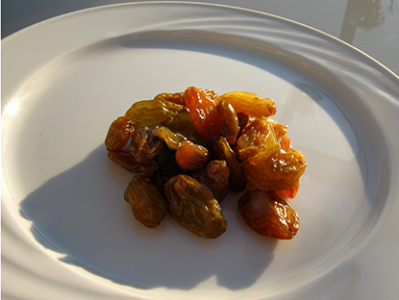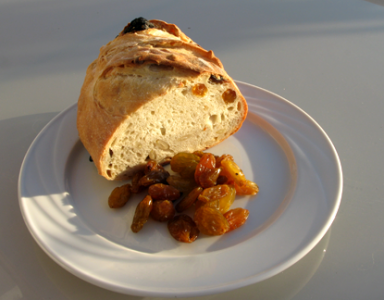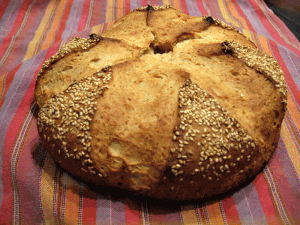“Something saporito,” she said. “With bits in.”
The Queen of Thanksgiving Turkeys wanted me to bring bread, and those were the specifications. I thought of a nice foccacia, but the timing was too difficult. A schoolnight, with a heavy day before it would not leave enough time. So it had to be a loaf. And the bits could not be cranberries, for all kinds of reasons. So I settled on sun-dried tomatoes and olives, and with absurd hubris thought I would just wing it. I’ve also been fooling around with chestnut flour and that seemed like a good idea. Also some durum flour. And heck, why not some wholemeal too, for even deeper flavour.
Step one was to activate my 100% starter, in three builds, to give me about 575 gm of leaven at 100% hydration. Weighed out into the big mixing bowl, it came in at 568 gm.
I wanted a total dough weight of 1400 gm at 65% hydration; 850 of flour and 550 of water. The starter provided 284 gm of each, leaving me to add 566 gm flour and 271 gm of water.
Somewhat arbitrarily, I decided on 10% each of chestnut flour and wholewheat flour, 40% of durum flour and the balance of Manitoba. To which I added 100 gm of sun-dried tomatoes softened in oil and 100 gm of green olives in oil. Baked to a rich, dark brown and delivered to the party, I failed to snap a single photograph. But it seemed to go down well. There was a hint of bitterness from the chestnut, which also added extra nuttiness, and the bits were pretty good too, the tomato especially offering little explosions of flavour in many, but not all, mouthfuls.
Saporito? I should say so.
Here is the detailed method.
Starting 24 hours before mixing, build starter. To 20 gm of starter, add 20 gm of soft flour and 20 gm of water, stir to mix and leave in a warm place for about 8 hours, until it is light and bubbly. To this, add another 95 gm each of flour and water, mix and leave another 8 hours. Finally, add 165 gm each of flour and water, mix and leave.
Weigh 570 gm of starter into a big mixing bowl. Add 271 gm of water and 330 gm of durum flour. Mix, and leave for 20 minutes to autolyse.
Prepare the tomatoes and olives. Drain off the oil and cut the tomatoes into strips about 1 cm wide. I use scissors for this, and to cut the olives in half crossways. Much easier than fiddling with a knife.
Add remaining dry ingredients — 85 gm fine chestnut flour, 85 gm wholewheat flour and 66 gm of strong bread flour — mix until you have a shaggy mass, then tip out onto the counter and knead to incorporate all the flour.
With bitty loaves like this one I vacillate about adding the bits with the flour or trying to incorporate them afterwards. Just the tomatoes, and I would add them with the flour, but you don’t want the kneading to break up the olives too much. So this time I patted the dough out on the counter, spread the cut up tomatoes and olives on it, rolled the whole lot up and started to knead gently. This is tricky. The oil around the bits tends to prevent the dough mixing in on itself, but persevere and gradually it will change from dough and bits more or less separate to dough with bits in.
Return the dough to the bowl and cover. After 45 minutes, tip the dough out and give it a quick stretch and fold. Return to the bowl and leave for another 45 minutes before giving another stretch and fold. Finally, return to the bowl and allow to rise for another 2 1/2 hours.
Tip the dough out onto a lightly floured board, divide in two and shape as you prefer. At this point I slipped the shaped loaves, in their bannetons, into a plastic bag and put them in the fridge overnight. I had to, given the timing. But I also wanted to, because the long, slow fermentation would help build lots of flavour. If you don’t refrigerate, allow the loaves to rise for an hour or so.
Heat the oven to 220°C (430°F), gently ease the loaves out onto a tray, slash and bake for 20 minutes. Turn the oven down to 205°C (400°F), rotate the loaves on the tray, and bake for a further 20 minutes. Cool on a wire rack.


